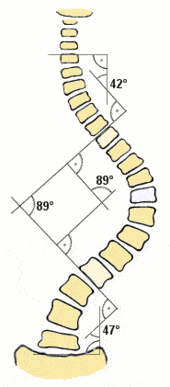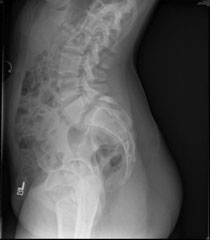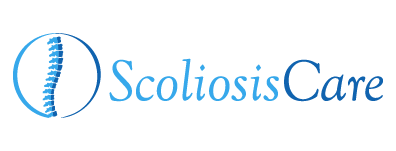Scoliosis & Spinal Disorders

What is Scoliosis?
Scoliosis is a medical condition in which a person’s spine is curved from side to side. Although it is a complex three-dimensional deformity, when it is viewed from the rear on an X-ray, the spine of an individual with typical Scoliosis may look more like an “S” or a “C” rather than a straight line.
Who can get Scoliosis?
Scoliosis can first appear in young children or even infants, but most often it shows up during middle to late childhood – a time when the spine and the rest of the body goes through a growth spurt. Girls are more likely than boys to develop idiopathic scoliosis.
What are the signs of Scoliosis?
One or both shoulder blades may be elevated, the waist may be lopsided, the hips may seem unusually high or the child may lean to one side. Additionally, a rib prominence (hump) may be seen from the back when the child bends forward.
What causes Scoliosis?
In most cases, Scoliosis arises for no apparent reason; this is called Idiopathic Scoliosis. Occasionally, Scoliosis is the result of an illness, birth defect (such as cerebral palsy) or a malformation of part of the spine during pregnancy; this is called Congenital Scoliosis.
What are the different types of Scoliosis?
Idiopathic Scoliosis
A curvature of the spine that usually occurs in children age 10 to maturity, but can occur in younger children or infants.
Neuromuscular Scoliosis
Also a curvature of the spine, but with a disorder of the neurological system such as cerebral palsy, spina bifida, muscular dystrophy or spinal cord injuries.
Congenital Scoliosis
A curvature of the spine that results from anomalies or abnormally developed vertebrae, which are the building blocks of the spinal column.
What are the suggested treatments for Scoliosis?
Monitoring
Some curves of the spine are mild and do not require treatment, but do need to be monitored periodically by examination and X-rays to ensure they don’t worsen.
Non-operative (brace or wheelchairs)
We measure the spinal curves in degrees. If a curve is fairly large (between 20 degrees and 40 degrees) and a child is still growing, a brace may be recommended to keep the curve from getting any worse. Any brace must be checked regularly to make sure the fit is as snug and comfortable as possible. A custom wheelchair may be suggested to help improve the sitting posture of children with neuromuscular scoliosis.
Operative (surgery)
Scoliosis surgery is one of the most extensive and complex orthopedic surgical procedures performed on children. However, recent advancements have improved the success and safety of these surgical procedures. Additionally, new surgical technology has eliminated the need for braces after surgery. The operation takes approximately four to six hours. Hospitalization can last several (usually around six) days and activities are restricted for several months.
Spondylolysis & Spondylolisthesis
What is Spondylolysis?
Spondylolysis is typically caused by a stress fracture of the lumbar spine, and is especially common in adolescents who overtrain in activities such as tennis, diving, martial arts and gymnastics. The stress fracture occurs at the pars interarticularis, a bridge between vertebral bone segments of the spine. The loss of this bony bridge can result in slippage of one bony segment over another that may cause painful instability. This slippage is called Spondylolisthesis. Spondylolysis also runs in families and is more prevalent in some populations, suggesting a hereditary component such as a tendency toward thin vertebral bone.


What are the signs of Spondylolysis?
An individual suffering from Spondylolysis and Spondylolisthesis may complain of activity related pain in the lower back, along with intermittent shocks of shooting pain beginning in the buttock traveling downward into the back of the thigh and lower leg. Sometimes symptoms include tingling and numbness. Typically pain is more severe in bending backward than forward.
What is the treatment of Spondyololysis?
Patients with symptomatic Spondylolysis and Spondylolisthesis are initially provided conservative treatment consisting of activity modification, anti-inflammatory medications (NSAIDS) and a physical therapy consultation. Occasionally if the pain is severe and conservative care fails surgery may be recommended. Surgery usually includes partial to full correction of the vertebral slippage and stabilization by means of surgical implants.
Scheuermann’s Disease
What is Scheuermann’s disease?
Scheuermann’s disease is a condition where the spine grows unevenly with respect to the sagital plane (looking at the individual from the side). The deformity arises when the back of the spine grows faster than the front. This uneven growth results in the signature “wedging” shape of the vertebrae, causing kyphosis, a forward rounding of the upper back.

What are the signs of Scheuermann’s disease?
Scheuermann’s disease is found mostly in teenagers and presents a significantly worse deformity than postural kyphosis. Individuals with Scheuermann’s disease have a visual hunchback or round back. Patients suffering with Scheuermann’s kyphosis cannot consciously correct their posture. The apex of the deformity is often located in the thoracic vertebrae and can be quite rigid. Scheuermann’s disease is notorious for causing lower and mid-level back pain, which can be severe and disabling. The sufferer may feel pain at the apex of the curve, which can be aggravated by physical activity and by long periods of standing or sitting. Additionally it has been found that many patients with Scheuermann’s disease also have a moderate degree of scoliosis.
What causes Scheuermann’s disease?
The cause is not currently known, and the condition appears to arise from multiple factors that are not clearly identified.
What is the treatment of Scheuermann’s disease?
For less extreme cases physical therapy and back braces can help reverse or stop the kyphosis before it becomes severe. Patients with severe kyphotic deformities and those that are likely to progress during growth are candidates for surgical correction. Surgery usually requires a spinal fusion of the involved spinal vertebrae using implants such as screws and rods to correct the deformity.
